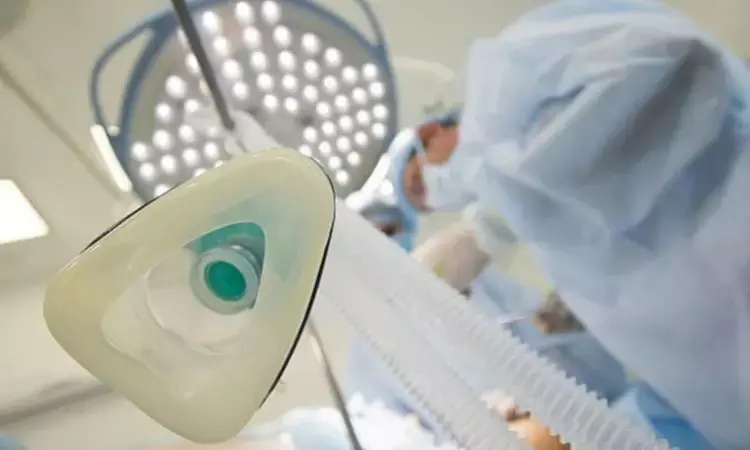- Home
- Medical news & Guidelines
- Anesthesiology
- Cardiology and CTVS
- Critical Care
- Dentistry
- Dermatology
- Diabetes and Endocrinology
- ENT
- Gastroenterology
- Medicine
- Nephrology
- Neurology
- Obstretics-Gynaecology
- Oncology
- Ophthalmology
- Orthopaedics
- Pediatrics-Neonatology
- Psychiatry
- Pulmonology
- Radiology
- Surgery
- Urology
- Laboratory Medicine
- Diet
- Nursing
- Paramedical
- Physiotherapy
- Health news
- Fact Check
- Bone Health Fact Check
- Brain Health Fact Check
- Cancer Related Fact Check
- Child Care Fact Check
- Dental and oral health fact check
- Diabetes and metabolic health fact check
- Diet and Nutrition Fact Check
- Eye and ENT Care Fact Check
- Fitness fact check
- Gut health fact check
- Heart health fact check
- Kidney health fact check
- Medical education fact check
- Men's health fact check
- Respiratory fact check
- Skin and hair care fact check
- Vaccine and Immunization fact check
- Women's health fact check
- AYUSH
- State News
- Andaman and Nicobar Islands
- Andhra Pradesh
- Arunachal Pradesh
- Assam
- Bihar
- Chandigarh
- Chattisgarh
- Dadra and Nagar Haveli
- Daman and Diu
- Delhi
- Goa
- Gujarat
- Haryana
- Himachal Pradesh
- Jammu & Kashmir
- Jharkhand
- Karnataka
- Kerala
- Ladakh
- Lakshadweep
- Madhya Pradesh
- Maharashtra
- Manipur
- Meghalaya
- Mizoram
- Nagaland
- Odisha
- Puducherry
- Punjab
- Rajasthan
- Sikkim
- Tamil Nadu
- Telangana
- Tripura
- Uttar Pradesh
- Uttrakhand
- West Bengal
- Medical Education
- Industry
New ultrasound therapy okay for patients not suitable for TAVR, SAVR

Delhi: Non-Invasive Ultrasound Therapy (NIUT) holds promise for the treatment of cardio-valvular diseases such as aortic stenosis, according to a recent study presented at PCR e-Course 2020.
Aortic stenosis is one of the leading causes of cardiovascular death worldwide. The non-invasive real-time image-guided medical device that uses a cutting-edge ultrasound technology, known as Pulsed Cavitational Ultrasound Therapy (PCUT), has been developed by Cardiawave (France).
This treatment is suitable for aortic stenosis patients who are either poor candidates for TAVR or SAVR or who have other reasons to avoid or prolong valve replacement, suggests a small, first-in-man trial.
The device allows physicians to deliver with a non-invasive medical device mechanical energy on a moving target with high precision, while at the same time preserving the tissue and organs through which the ultrasound passes. Unlike any existing technology, it is possible to target and treat, almost simultaneously, several anatomical zones spread over a large area without physically moving the medical device, which is placed on the patient's chest, over the beating heart. Treatment is monitored in real-time.
In the study, 10 patients ranged in age from 77 to 93 years were included.
Overall, six of 10 patients were considered "responders" because they experienced both aortic valve area increases and mean pressure gradient decreases together with improvement or stabilization of their NYHA functional class. All patients in the study did not receive the same treatment duration, which could explain individual differences in response to the therapy, as could the position of the patient on the table.
Ultrasound duration ranged from only 36 minutes to as much as 60 minutes. All patients who were considered responders received at least 45 minutes of therapy and a mean acoustic energy level of 180 J/mm2.
Key findings of the study include:
- At 6-month follow-up, one of the six responders had died compared with two of the four nonresponders.
- The increase in aortic valve area was maintained in responders.
- Only one patient, with a 47% reduction in mean aortic valve gradient at 30 days, had what could be called a "robust response" to the therapy.
- All ten patients still had severe aortic stenosis at 1 month as measured by aortic valve area.
"Further studies will be necessary to confirm the efficacy of the ultrasound procedure before its use could potentially be expanded to patients with a wide range of reasons for not undergoing TAVR or SAVR," concluded the authors.
The study, "Non-invasive ultrasound treatment of calcific aortic stenosis: first-in-man," was presented at the PCR e-Course 2020 meeting on June 25, 2020.
Dr Kamal Kant Kohli-MBBS, DTCD- a chest specialist with more than 30 years of practice and a flair for writing clinical articles, Dr Kamal Kant Kohli joined Medical Dialogues as a Chief Editor of Medical News. Besides writing articles, as an editor, he proofreads and verifies all the medical content published on Medical Dialogues including those coming from journals, studies,medical conferences,guidelines etc. Email: drkohli@medicaldialogues.in. Contact no. 011-43720751


